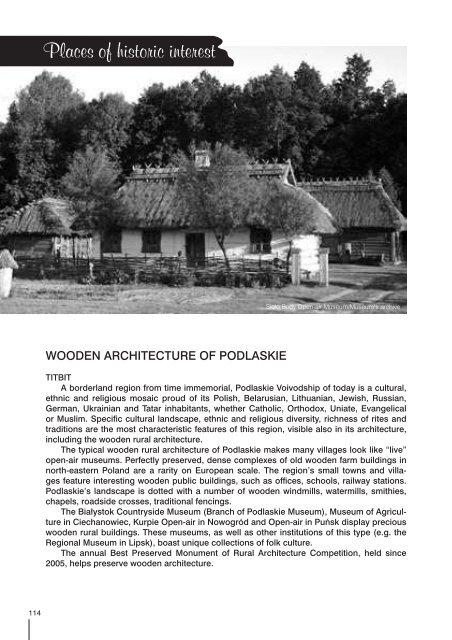You also want an ePaper? Increase the reach of your titles
YUMPU automatically turns print PDFs into web optimized ePapers that Google loves.
Places of historic interest<br />
Ciekawostka<br />
WOODEN ARCHITECTURE OF PODLASKIE<br />
Sio³o Budy Open-air Museum/Museum’s archive<br />
TITBIT<br />
A borderland region from time immemorial, <strong>Podlaskie</strong> Voivodship of today is a cultural,<br />
ethnic and religious mosaic proud of its Polish, Belarusian, Lithuanian, Jewish, Russian,<br />
German, Ukrainian and Tatar inhabitants, whether Catholic, Orthodox, Uniate, Evangelical<br />
or Muslim. Specific cultural landscape, ethnic and religious diversity, richness of rites and<br />
traditions are the most characteristic features of this region, visible also in its architecture,<br />
including the wooden rural architecture.<br />
The typical wooden rural architecture of <strong>Podlaskie</strong> makes many villages look like “live”<br />
open-air museums. Perfectly preserved, dense complexes of old wooden farm buildings in<br />
north-eastern Poland are a rarity on European scale. The region’s small towns and villages<br />
feature interesting wooden public buildings, such as offices, schools, railway stations.<br />
<strong>Podlaskie</strong>’s landscape is dotted with a number of wooden windmills, watermills, smithies,<br />
chapels, roadside crosses, traditional fencings.<br />
The Bia³ystok Countryside Museum (Branch of <strong>Podlaskie</strong> Museum), Museum of Agriculture<br />
in Ciechanowiec, Kurpie Open-air in Nowogród and Open-air in Puñsk display precious<br />
wooden rural buildings. These museums, as well as other institutions of this type (e.g. the<br />
Regional Museum in Lipsk), boast unique collections of folk culture.<br />
The annual Best Preserved Monument of Rural Architecture Competition, held since<br />
2005, helps preserve wooden architecture.<br />
AUGUSTÓW COUNTY<br />
Augustów<br />
• Yacht Club Complex, 1933-37, including Yacht<br />
Club building, wooden porter’s lodge, marina,<br />
forest park,<br />
• Mid-16th c. urban layout with Zygmunt August<br />
Sq., transformed into a park in 1860, rows of<br />
19 th c. tenement houses,<br />
• Holiest Heart of Jesus Minor Basilica, 1906-11,<br />
eclectic style,<br />
• Old Post-Office with park, typical H. Marconi<br />
design, 1829, at present 1st Grade Music<br />
School,<br />
• Tombs in the parish cemetery, 1800, with the<br />
oldest and grandest ones focused around the<br />
cemetery chapel funded by the Truszkowski<br />
Family in 1820, a number of iron castings<br />
from the Sztabin Metalworks,<br />
• Augustów Canal – most attractive water route<br />
in <strong>Podlaskie</strong>, built 1823-1839 by Gen. Ignacy<br />
P¹dzyñski. Military shelters in Promiski, Gliniski,<br />
Augustów and Sucha Rzeczka built by<br />
Polish Army in 1939.<br />
Augustów – Studzieniczna<br />
• Our Lady of Szkaplerz Parish Church Complex,<br />
1836, interior antler decorations,<br />
Chapel accessible through a causeway, 1920,<br />
painting of Our Lady of Studzieniczna, nearby<br />
well supplying water, which, according to local<br />
legends, “miraculously cures diseases”,<br />
• Augustów Canal with buildings and installations,<br />
1825-39.<br />
Gabowe Gr¹dy<br />
• Wooden Old Believers’ Church built on eastwest<br />
axis.<br />
Krasnybór<br />
• Annunciation of Holy Virgin Mary Church, former<br />
Uniate Orthodox Church, 1614,<br />
• Tower, first mentioned in mid-19 th c., probably<br />
built the Dominican monks in 18 th c., interior<br />
frescoes, painting of Holy Virgin Mary and<br />
Baby Jesus (early 17 th c.), sculpture of Crucified<br />
Christ (17 th /18 th c.),<br />
• Manor-like brick presbytery, 1939, built in<br />
place of former monastery,<br />
• St. Roch Church,1870,<br />
• Tomb of Wiktoria Rymaszewska with 4 castiron<br />
columns, 19 th c.<br />
Lipsk<br />
• Late 16 th c. grid urban layout,<br />
• Neo-gothic Our Lady of Angels Church, 1906<br />
– 1914, precious icon of Our Lady “the Basilian”<br />
with Baby Jesus, 16 th /17 th c.,<br />
• Catholic House, 20s 20 th c.<br />
• Freedom Mound commemorating Polish assumption<br />
of independence in 1918,<br />
• Residential buildings, early 20 th c.,<br />
• Military shelters on so-called Molotow line,<br />
1940-41.<br />
Mikaszówka<br />
• One-nave wooden St. Maria Magdalena<br />
Church, 1907, with two towers and original interior<br />
antler decorations, nearby wooden bell<br />
tower and cast-iron monument from Sztabin<br />
Metalworks,<br />
• Mikaszówka – one of the locks on Augustów<br />
Canal, 1828.<br />
Rudawka<br />
• Kudrynki and Kurzyniec – locks on Augustów<br />
Canal, 1829, Kurzyniec lock is a Polish-Belarusian<br />
border crossing.<br />
Sztabin<br />
• 18 th c. urban layout designed by Joachim<br />
Chreptowicz,<br />
• Neo-gothic St. Jacob the Apostle Church,<br />
1905 – 10,<br />
• sundial and cast-iron bust of Joachim Chreptowicz,<br />
19 th c.<br />
Œwiête Miejsce<br />
• Sacred spot on Rospuda River in the vicinity<br />
of the village of Jaœki, ancient place of pagan<br />
cult later adapted by the Catholic Church,<br />
place of Midsummer Day celebrations (June<br />
24 th ).<br />
114 115<br />
16<br />
Places of historic interest


